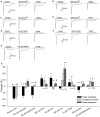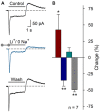Acid-Sensing Ion Channels Expression, Identity and Role in the Excitability of the Cochlear Afferent Neurons
- PMID: 26733809
- PMCID: PMC4686812
- DOI: 10.3389/fncel.2015.00483
Acid-Sensing Ion Channels Expression, Identity and Role in the Excitability of the Cochlear Afferent Neurons
Abstract
Acid-sensing ion channels (ASICs) are activated by an increase in the extracellular proton concentration. There are four genes (ASIC1-4) that encode six subunits, and they are involved in diverse neuronal functions, such as mechanosensation, learning and memory, nociception, and modulation of retinal function. In this study, we characterize the ASIC currents of spiral ganglion neurons (SGNs). These ASIC currents are primarily carried by Na(+), exhibit fast activation and desensitization, display a pH50 of 6.2 and are blocked by amiloride, indicating that these are ASIC currents. The ASIC currents were further characterized using several pharmacological tools. Gadolinium and acetylsalicylic acid reduced these currents, and FMRFamide, zinc (at high concentrations) and N,N,N',N'-tetrakis-(2-piridilmetil)-ethylenediamine increased them, indicating that functional ASICs are composed of the subunits ASIC1, ASIC2, and ASIC3. Neomycin and streptomycin reduced the desensitization rate of the ASIC current in SGNs, indicating that ASICs may contribute to the ototoxic action of aminoglycosides. RT-PCR of the spiral ganglion revealed significant expression of all ASIC subunits. By immunohistochemistry the expression of the ASIC1a, ASIC2a, ASIC2b, and ASIC3 subunits was detected in SGNs. Although only a few SGNs exhibited action potential firing in response to an acidic stimulus, protons in the extracellular solution modulated SGN activity during sinusoidal stimulation. Our results show that protons modulate the excitability of SGNs via ASICs.
Keywords: ASIC; Corti; FMRFamide; acetylsalicylic acid; aminglycosides; auditory; inner ear; spiral ganglion.
Figures










Similar articles
-
Functional characterization of acid-sensing ion channels in cultured neurons of rat inferior colliculus.Neuroscience. 2008 Jun 23;154(2):461-72. doi: 10.1016/j.neuroscience.2008.03.040. Epub 2008 Mar 26. Neuroscience. 2008. PMID: 18456416
-
Acid-sensing ion channels (ASICs) in mouse skeletal muscle afferents are heteromers composed of ASIC1a, ASIC2, and ASIC3 subunits.FASEB J. 2013 Feb;27(2):793-802. doi: 10.1096/fj.12-220400. Epub 2012 Oct 29. FASEB J. 2013. PMID: 23109675 Free PMC article.
-
The expression profile of acid-sensing ion channel (ASIC) subunits ASIC1a, ASIC1b, ASIC2a, ASIC2b, and ASIC3 in the esophageal vagal afferent nerve subtypes.Am J Physiol Gastrointest Liver Physiol. 2014 Nov 1;307(9):G922-30. doi: 10.1152/ajpgi.00129.2014. Epub 2014 Sep 4. Am J Physiol Gastrointest Liver Physiol. 2014. PMID: 25190475 Free PMC article.
-
Acid-Sensing Ion Channels: Focus on Physiological and Some Pathological Roles in the Brain.Curr Neuropharmacol. 2021;19(9):1570-1589. doi: 10.2174/1570159X19666210125151824. Curr Neuropharmacol. 2021. PMID: 33550975 Free PMC article. Review.
-
Acid-Sensing Ion Channels and Mechanosensation.Int J Mol Sci. 2021 May 1;22(9):4810. doi: 10.3390/ijms22094810. Int J Mol Sci. 2021. PMID: 34062742 Free PMC article. Review.
Cited by
-
Protons as Messengers of Intercellular Communication in the Nervous System.Front Cell Neurosci. 2018 Oct 10;12:342. doi: 10.3389/fncel.2018.00342. eCollection 2018. Front Cell Neurosci. 2018. PMID: 30364044 Free PMC article. Review.
-
Acid-sensing ion channels (ASICs) influence excitability of stellate neurons in the mouse cochlear nucleus.J Comp Physiol A Neuroethol Sens Neural Behav Physiol. 2019 Oct;205(5):769-781. doi: 10.1007/s00359-019-01365-x. Epub 2019 Aug 26. J Comp Physiol A Neuroethol Sens Neural Behav Physiol. 2019. PMID: 31451914
-
Locus Coeruleus Acid-Sensing Ion Channels Modulate Sleep-Wakefulness and State Transition from NREM to REM Sleep in the Rat.Neurosci Bull. 2021 May;37(5):684-700. doi: 10.1007/s12264-020-00625-0. Epub 2021 Feb 27. Neurosci Bull. 2021. PMID: 33638800 Free PMC article.
-
Glucose Deficiency Elevates Acid-Sensing Ion Channel 2a Expression and Increases Seizure Susceptibility in Temporal Lobe Epilepsy.Sci Rep. 2017 Jul 19;7(1):5870. doi: 10.1038/s41598-017-05038-0. Sci Rep. 2017. PMID: 28725010 Free PMC article.
-
Diverse identities and sites of action of cochlear neurotransmitters.Hear Res. 2022 Jun;419:108278. doi: 10.1016/j.heares.2021.108278. Epub 2021 May 24. Hear Res. 2022. PMID: 34108087 Free PMC article. Review.
References
LinkOut - more resources
Full Text Sources
Other Literature Sources

